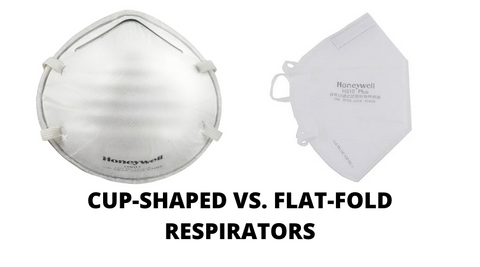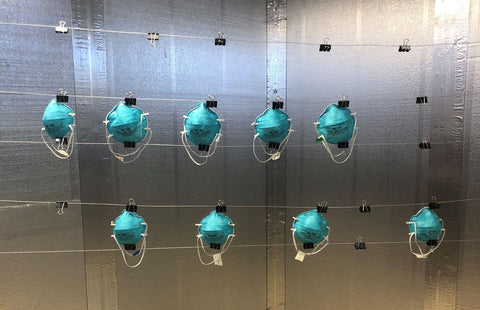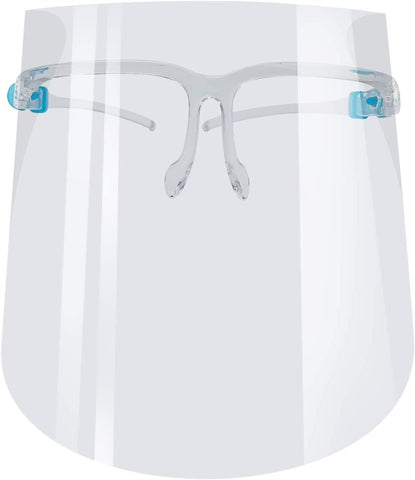KN95 vs N95 respirator: The ULTIMATE GUIDE about mask certification, ratings and standards
KN95 respirator is a Chinese filtering facepiece respirator (FFR) that meets the Chinese performance standard GB2626–2006. KN95 respirators filter ≥ 95% of particles of 0.3 microns.
N95 respirator is a USA respirator that meets the US performance standard NIOSH-42CFR84. N95 respirators also filter ≥ 95% of particles of 0.3 microns.
According to 3M, “based on this comparison, it is reasonable to consider China KN95, as “similar” to US NIOSH N95, for filtering non-oil-based particles such as bioaerosols (e.g. viruses).”
That’s the short answer. Let me give you the long answer in THE ULTIMATE GUIDE to KN95 vs. N95.
OUTLINE:
- Standard N95 vs. Surgical Mask vs. Surgical N95 vs. KN95
- Earloops vs headwraps
- Cup-shaped vs flat-folding
- Sterilizing N95 vs KN95

Standard N95 vs. Surgical Mask vs. Surgical N95 vs. KN95
U.S. National Institute of Occupational Safety and Health (NIOSH) tests and certifies respirators as N95 when they have filtration efficiency of at least 95% against non-oily particles. The intended purpose of the N95 respirator is to reduce the exposure to small particle aerosols and large droplets.
U.S. Food and Drug Administration (FDA) clears surgical masks to be worn by healthcare professionals during surgical procedures when they are fluid resistant - the ability of masks to resist penetration by high-pressure streams of liquid, such as those that might result from a human artery being punctured during surgery. This standard is called ASTM F1862: Standard Test Method for Resistance of Medical Face Masks to Penetration by Synthetic Blood. Surgical masks are loose-fitting, not required to have fit-testing, leak around the edge of the mask, and does not provide 95% filtration. The intended purpose of the surgical mask is to provide fluid resistance, protect again large droplets, and reduce the wearer’s respiratory emissions.
When an N95 respirator is approved by both NIOSH and cleared by the FDA, then this is called a Surgical/Medical N95. The intended purpose of the Surgical N95 Respirator is to reduce the exposure to small particle aerosol both inhaled and exhaled by wearer AND provide fluid resistance.
Does every single healthcare worker need SURGICAL N95? CDC recommends that we may prioritize Surgical N95 to those who need respiratory protection WHILE performing surgery or task that exposes a person to high-pressure streams of bodily fluid. For other healthcare workers who are not performing surgery or exposed to high-velocity body fluids, a standard NIOSH N95 can be worn to reduce the worker’s exposure to the patient’s airborne virus. Many hospitals have taken the extra step of asking the healthcare worker to wear a standard surgical mask to cover the top of the non-surgical NIOSH N95 respirator for added protection.
What about KN95? A quality KN95 respirator that filters ≥ 95% of particles of 0.3 microns under the Chinese performance standard GB2626–2006 is similar to NIOSH N95 under the US performance standard NIOSH-42CFR84. A healthcare worker may use a KN95 respirator as a NIOSH N95 if the following conditions are met:
- Qualified KN95: manufacture has been authorized by the FDA for emergency use during the COVID-19 emergency AND tested by the CDC for proof of 95% filtration. Here is a list of KN95 manufactures on the FDA Appendix A that had their respirators tested by the CDC.
- Individual testing: fit testing is performed by the wearer.
- For added protection, the healthcare worker can wear a surgical mask on top of the KN95 for fluid resistance.
3M has a great PDF about the difference between surgical and standard N95 and consideration when selecting a respirator versus a surgical mask. To summarize, there are 3 types of classifications: NIOSH-Approved N95 Respirators, FDA-Cleared Surgical Masks, and Surgical N95 Respirators. CDC also provides a good summary as well.
Conclusion: Surgical NIOSH N95 is superior to NIOSH N95 and KN95 (that are FDA authorized AND CDC tested) in that it provides fluid resistance. However, all have been FDA authorized to use in healthcare setting under the EUA.

Earloops vs headwraps
This key difference has lead to much confusion. YES, there are KN95s with earloops that are quality respirators that PASSES the fit testing. However, there are KN95s with earloops that fail the fit testing. The confusion started with the manufacturer called Dasheng that made a NIOSH N95 with headwrap that also started to make earloop KN95 for use in China, but put them both in the same NIOSH N95 box. Once these Dasheng earloop KN95s with the mislabeled boxes started to arrive in the US, they were called counterfeit NIOSH N95, because they were not NIOSH approved with headwraps. However, the counterfeiting was actually a mislabeling by the manufacture and NOT actual counterfeits (although Dasheng later claims that actual counterfeits of their mislabeled KN95 respirator actually exist). The CDC later discovered that these “mislabeled KN95s as NIOSH N95s” were actually great in quality. This confusion was made worse by new KN95 manufacturers that produced poor quality earloops that were either too loose or easily break or mislabeled their products with CDC or FDA logos.
Chinese hospitals use N95 respirators during surgical and high-risk procedures and not KN95 respirators when working with COVID-19 patients. The Chinese government went as far as nationalizing several N95 manufacturers (such as Dasheng and Makrite) and prevented them from exporting them. These N95 respirators typically have headwraps.
Even the CDC recommends caution when using respirators with earloops. “Preliminary NIOSH assessments indicate it is difficult to achieve an adequate fit when wearing respirators with earloop designs. (NIOSH-approved respirators generally do not have ear loops.)” The CDC further cautions that your organization conduct “a fit test with multiple people (with varied facial structures).”
Conclusion: CDC states that headwrap is better than earloops when achieving an adequate fit. If you purchase either headwrap or earloop respirators, then you still need to conduct a fit test with multiple people.
Does headwrap KN95s exist? Why yes they do. Many quality manufacturers like 3M and Honeywell produce KN95 with earloop designs. Once again, not ALL earloops are poor in quality. 3M also provides a webpage to help you understand the difference and a list of 3M imported respirator that you may see on the market. Besides companies like 3M and Honeywell, I’ve also asked Chinese manufacturers to produce their KN95s with headwrap instead of earloops.

Cup-shaped vs flat-folding
When we think about Surgical N95 respirator, we immediately think of the 3M 1860 N95 with its blue colored cup. These come in two sizes and we are fit tested at our hospitals to determine which cup size has a superior fit. At a different hospital, I was always provided with a folding Surgical N95 with a headwrap, which I found to be more comfortable and superior in fit. Well, this is actually what was discovered in research studies. A study in 2013 found that “more individuals passed fit testing wearing flat-fold respirators”. They concluded that the flat-fold N95 “offers the possibility of enhanced facial comfort without a loss of protection”. Another study in 2017 found that “the fold-type respirator had a significantly greater protection rate at baseline compared to the cup-type and valve-type respirators.” I never knew that these studies ever existed before COVID-19, but many of us in healthcare felt that folding Surgical N95s were more superior to the cup-shaped.
Conclusion: flat-folding N95 can be more comfortable and provide greater protection (based on your fit testing).

Sterilizing N95 vs KN95
Many hospitals are rationing respirators to their healthcare workers. FDA has issued an Emergency Use Authorization to N95 decontamination devices. While many of us in healthcare understand the rationale of this strategy due to the shortage, we still question the effectiveness and safety of this process. The Massachusetts Nurses Association (MNA) and National Nurses United came out against decontamination as it does not meet these three criteria: (1) it must effectively inactivate the pathogen, (2) it must not degrade the performance of the respirator including filtration, structural integrity, and face seal, and (3) it must not introduce an additional hazard to the worker wearing the respirator.” Many staff members are complaining of “dizziness, headaches, and nausea with use of the chemically and UV cleaned masks.”
Many in the scientific community feel that research on decontamination lacks the real-life (in vivo) testing needed as most of the research is performed on mannequins. For example, the research on the Battelle decontamination system was performed in a controlled environment with mannequin heads and not in real-life situations. This system was NOT tested to see if N95 can be worn on a human being (not a mannequin) for 12 hours in one day and then sterilized 20 times. People who think that disinfecting N95 up to 20 times (government, hospital administrators & Battelle) should actually try using a respirator that has been worn in real life for 12 hours and disinfected once, or twice after up to 24 hours of use. By the way, Battelle got a $400 million contract that ended up costing the government more than $110 to decontaminate one respirator.
What about sterilizing Chinese N95 or KN95? Forget about it. CDC and the FDA have stated that “authorized respirators listed in Appendix A will no longer be authorized if decontaminated”.
Is there a better desterilization method? A recent study found that sterilization with hydrogen peroxide had fewer negative effects than chlorine dioxide in preserving the filtration efficiency in a lab study. Interestingly, this study also tested N95, KN95, and surgical masks. The research limitations were many including the testing of filtration after only one sterilization cycle instead of multiple cycles.
Conclusion: Sterilizing N95 is not well tested in real-life situations, and sterilizing KN95 is not authorized.

Bonus Infomation
We are so focused on protecting our nose and mouth, that we neglect our eyes. A recent meta-analysis found that eye protection was associated with less virus transmission of SARS-CoV-2 and MERS. So, put on your goggles and face shields everybody.
About the author:
https://www.linkedin.com/in/jayparkmd/
Do you need N95 or KN95 in small quantity?
KN95RespiratorMasksForSale.com
Are you buying PPE for hospitals or government agencies?
PPEConnector.com
Want to read more about PPE?
KN95 Part 1: How to Spot a Fake KN95 Respirator Mask from China.
How to verify a legitimate KN95 manufacturer or supplier? Hint: Google